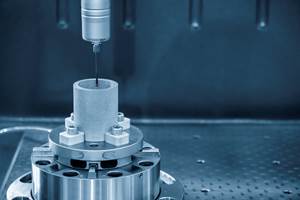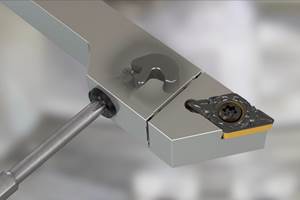Multi-Directional Turning System Quadruples Output Rate
Here's a look at a production machining contractor utilizing state-of-the-art CNC machine tools to produce components for suppliers and OEMs in the automotive, transportation equipment, and machine tool industries.
Share






Sematco, Inc., Roanoke, Virginia, is a production machining contractor utilizing state-of-the-art CNC machine tools to produce components for suppliers and OEMs in the automotive, transportation equipment, and machine tool industries.
A current job is the machining of piston spools for a major transportation equipment supplier. The component is part of the pneumatic starter system used in trucks and buses, and is produced as finished in volumes of 200 pieces per month. Productivity in these operations was recently dramatically increased, when Sematco replaced existing tooling with an innovative "multi-directional" turning system that has eliminated the need for two tools and greatly improved effective tool life.
The machining operations performed on the piston spools are run on a rigid, late-model 15-hp turning center. Starting from 303 stainless-steel bar stock, a series of plunging cuts and approximately four inch-long OD turning cuts are taken to produce the finished part. Part tolerance requirements are ¤0.001 inch (0.025 mm) on diameter and concentricity, with a surface finish of 63 rms.
Original tooling for these operations consisted of a facing tool and grooving tool. The grooving tool was cycled to perform both rough and finish plunge-cutting and side turning of the part profile. The tool proved unsuitable for the side turning operations however, and also required insert indexing, on average, after every other part. For this reason, right- and left-hand turning tools were added to the machining cycle, and the grooving tool was used for plunge cutting only.
There were problems with this program, however. Rough machining rates for the side turning tools, which took a 0.035 inch depth of cut, were limited to a cutting speed of 350 sfm and a feed rate of 0.003 ipr. Moreover, because the part walls are thin, finish cuts had to be run at a very slow 45 sfm to avoid chatter marks. Even so, the parts required secondary polishing to meet surface finish specs. Given the combination of low cutting parameters and secondary polishing, Sematco was able to produce an average of only 1.5 piston spools per hour.
Seeking to improve productivity in these operations, Sematco contacted Salem Tools, Salem, Virginia., a distributor for Carboloy Inc., Detroit, Michigan. Salem Cutting Tool Specialist Ron Vess recommended testing Carboloy's multi-directional turning (MDT) system. The MDT system consists of three toolholders that are combined, respectively, with small carbide indexable inserts in widths of 1/8 inch, 3/16 inch, and 1/4 inch, or 3 mm, 4 mm, 5 mm and 6 mm. Each insert/holder combination forms an integrated system capable of grooving, left- and right-hand side turning, profiling, facing, and cut-off. A patented feature of the tools is serrations on the bottom of the insert and the insert pocket in the toolholder that provide stronger, more secure insert retention for deeper cuts, enhanced resistance to high cutting forces, and better surface finishes.
With the MDT system, Sematco is able to perform all OD turning on the piston spools using only two MDT tools-one for roughing, the other for finishing. The roughing tool holds a 4 mm insert with a square-shoulder geometry selected in Carboloy's versatile and very tough CP50 PVD-coated grade. The tool is used first to face off the part; then, in the plunge roughing cycle, to cut the OD grooves. Next, the entire profile is finished with an MDT tool using a 4 mm profiling insert, also in Carboloy's tough CP50 grade. The roughing operation takes a 0.075 inch depth of cut at a cutting speed of 415 sfm and a feed rate of 0.009 ipr. The finishing operation is run at a 0.010 inch depth of cut, a cutting speed of 400 sfm, and a feed of 0.010 ipr. The MDT finishing tool produces seven completely machined parts per hour, using just a single insert edge and achieving a fine finish that eliminates the need for secondary hand polishing. The insert is systematically indexed after an hour's use, though so far no chipping has occurred and only normal flank wear has been detected.
Using the MDT tooling, Sematco has more than quadrupled its output rate in machining the piston spools. Much of this gain is attributable to faster speeds and feeds in roughing and finishing, but productivity has also been enhanced through reduced indexing of inserts and fewer turret cycles. At the same time, improved tool performance has cut insert consumption by more than 75 percent and also eliminated the hand polishing operation.
The Carboloy MDT system is designed to reduce the number of tools required for machining a given part. According to Carboloy Technical Specialist Dave Richardson, this innovation not only reduces tooling costs, but also setup and machining cycle time. "Frequently, only one or two tools need be programmed and installed in the machine-which also significantly reduces turret cycle time," Mr. Richardson says. He notes, too, that the multi-directional tools make more efficient use of sometimes limited turret stations.
Both the inch and metric inserts are available in single- and double-ended versions. The single-ended version provides a "reach" of five times the insert width, and the double-ended version a reach of three times the insert width. MMS
Related Content
The Future of High Feed Milling in Modern Manufacturing
Achieve higher metal removal rates and enhanced predictability with ISCAR’s advanced high-feed milling tools — optimized for today’s competitive global market.
Read MoreParts and Programs: Setup for Success
Tips for program and work setups that can simplify adjustments and troubleshooting.
Read MoreQuick-Change Tool Heads Reduce Setup on Swiss-Type Turning Centers
This new quick-change tooling system enables shops to get more production from their Swiss turning centers through reduced tool setup time and matches the performance of a solid tool.
Read MoreShoulder Milling Cuts Racing Part's Cycle Time By Over 50%
Pairing a shoulder mill with a five-axis machine has cut costs and cycle times for one of TTI Machine’s parts, enabling it to support a niche racing community.
Read MoreRead Next
AMRs Are Moving Into Manufacturing: 4 Considerations for Implementation
AMRs can provide a flexible, easy-to-use automation platform so long as manufacturers choose a suitable task and prepare their facilities.
Read MoreMachine Shop MBA
Making Chips and 91ÊÓƵÍøÕ¾ÎÛ are teaming up for a new podcast series called Machine Shop MBA—designed to help manufacturers measure their success against the industry’s best. Through the lens of the Top Shops benchmarking program, the series explores the KPIs that set high-performing shops apart, from machine utilization and first-pass yield to employee engagement and revenue per employee.
Read More




















